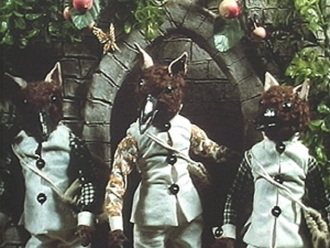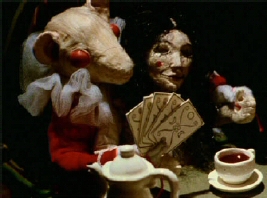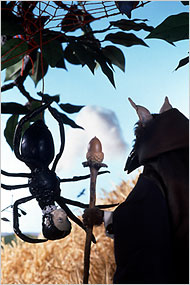
13 CURIOS FROM THE NEW CENTURY: part II
page 2
christopher funderburg
The Power of Nightmares

Ever since the confluence of Bowling for Columbine grossing $20 million and George Bush's disastrous run in the White House, documentaries that exist solely to espouse a political point of view have been bountiful. The obvious problem with the vast majority these films is that they are pathetically un-cinematic – as a matter of fact, it's Moore's talents as a filmmaker more than his politics that set him apart from the legions following in his wake. With these political pamphlets masquerading as films (Save the dolphins! Buy organic! Honor killings are bad!), the best you can generally hope for are some moments of pretty cinematography overlaid on the Important Messages and such surface pleasures are unlikely.
What separates Adam Curtis three part BBC mini-series The Power of Nightmares from the rabble is not its critique, but its methods. The film is a lengthy essay examining the intertwined histories of modern Islamic fundamentalism and Western Neo-Conservatism, but the subject is rendered through a singular collage of pop materials. The soundtrack is driven by recognizable themes appropriated from other scores like John Carpenter's Halloween and Ennio Morricone’s Investigation of a Citizen above Suspicion. Interspersed throughout the film is an evocative selection of clips from old horror films and assorted b-movies. Brian Eno’s "Another Green World" is employed to create some memorably moody sections and bits of noise from Skinny Puppy pop up in unexpected places. It even deftly handles Moore's old standby: the stock footage montage used to an acidly humorous, ironic effect.
In one branch, the film traces Islamic fundamentalisms roots down the well-known path from Sayyid Qutb to Ayman al-Zawahiri to Osama Bin Laden but constantly stops to focus on the surprising and idiosyncratic ephemera the pamphlet films generally shunt aside: for instance, is the pop standard "Baby, it's cold outside" at the root of anti-progressive Islamic thought? It's a strange notion - and when Curtis uncovers the historical footnote that begs this question, he has the savvy to understand that in filmmaking the footnotes supersede the text. You'll never again be able to hear that song without conjuring up the truly strange associations explicated in the film. Rather than pushing ideas, he asks questions and follows the answers down strange, unexpected avenues. What is the actual definition of "Al Qaeda?" Does it refer to an actual entity that exists in some concrete way or rather a constellation of associated sentiments?
 On the Neo-Conservative side, the film traces the well-known path from Leo Strauss to Paul Wolfowitz to Ronald Regan, Donald Rumsfeld and Douglas Feith. As Curtis examines how the Neo-Conservatives use the politics of fear to their advantage, his two main points become clear: 1) these two groups, the Neo-Conservatives and the Islamic Fundamentalists are intertwined not just by the vagaries of history, but because they need each other on a fundamental level. 2) To manipulate fear on a mass scale, both groups must tap into the collective fantasy life of their respective cultures.
On the Neo-Conservative side, the film traces the well-known path from Leo Strauss to Paul Wolfowitz to Ronald Regan, Donald Rumsfeld and Douglas Feith. As Curtis examines how the Neo-Conservatives use the politics of fear to their advantage, his two main points become clear: 1) these two groups, the Neo-Conservatives and the Islamic Fundamentalists are intertwined not just by the vagaries of history, but because they need each other on a fundamental level. 2) To manipulate fear on a mass scale, both groups must tap into the collective fantasy life of their respective cultures.
In the context of the latter point, the heavy use of appropriated soundtracks and images (which sets the film apart from those political pamphlet films) isn't just a shallow sleight of hand, honey to make the bitter medicine go down sweet: if a group wishes to manipulate culture on the whole, they are by definition manipulating popular culture. So, the film has an acute awareness of the pop contexts in which all these deadly serious issues exist, and the extent to which these deadly serious political issues are at their core pop issues. Pop culture is at its root an expression of and reaction to shared fantasies on a mass scale. To create a climate of fear and control that climate, both the Islamic Fundamentalists and the Neo-Conservatives must work with pop materials - Curtis' own use of these same kind of images, sounds, songs and books serves as an illustration, critique and resistance.
Ultimately, Curtis' film belongs to an entirely different category of filmmaking from issue-minded political documentaries. Just as it would be erroneous to file the work of Errol Morris and Fred Wiseman away with those films, so it would be wrong to ghettoize Curtis' work in that limited context. An improbably imaginative and creative film about the relationship between psychology and public policy, Curtis has stepped beyond simply trying to score points about the appropriate course of action, about "rightness" in liberals vs. reactionaries, about the most enlightened band of the political spectrum and has created one of the few works to actual tackle the complex intersection of politics and humanity, the point where cold hard policy meets the inevitable irrationality of human fantasy. Baby, it's cold outside
Blood Tea and Red String
 This film will someday have the reputation it deserves; it is impossible that a film this amazing and original will someday drop anonymously into to the yawn of history. Instead, it will be slowly discovered by an ever-growing legion that will preserve it against time and memory. Count me among them. Easily the best film on this list and probably the best film you have never heard of, Christiane Cegavske's stop-motion animated bibelot feels like an artifact from another time and world. Crafted with hand-made care and a boggling attention to miniscule, delicate details, the film is so elaborate and evocative as to almost be tactile. It's the rare film that seems not simply to be framed as an artwork on a screen, but to exist.
This film will someday have the reputation it deserves; it is impossible that a film this amazing and original will someday drop anonymously into to the yawn of history. Instead, it will be slowly discovered by an ever-growing legion that will preserve it against time and memory. Count me among them. Easily the best film on this list and probably the best film you have never heard of, Christiane Cegavske's stop-motion animated bibelot feels like an artifact from another time and world. Crafted with hand-made care and a boggling attention to miniscule, delicate details, the film is so elaborate and evocative as to almost be tactile. It's the rare film that seems not simply to be framed as an artwork on a screen, but to exist.
The simple storyline follows a family of peasant-clothing-clad bird/squirrel creatures and their journey to reclaim a doll stolen by a group of aristocratically-attired albino mice. The bulk of the running time is spent simply living in the bizarre and delicate world created by Cegavske – she's got an obsessive’s attention to small details like fabric patterns and background foliage and as much as the story and characters are borrowed archetypes, the project builds to an utterly original whole that has so much shock and suspense that your viewing experience is akin to something like hearing "Little Red Riding Hood" for the first time. It's a bizarre mélange of melancholy, adventure, psychedelica, and violence – the albino mice in particular are wonderful creations: their demeanor veers from essentially innocuous (in parts they reminded me of a group of unsupervised children) to grotesque and terrifying (in other parts they reminded me of nothing so much as the backwoods family from The Texas Chain Saw Massacre).
 Aside from the remarkable over-all tone, Blood Tea is filled with amazing individual sequences - fantastic moments where the remarkable art design comes together perfectly with the narrative. For example, at one point on the bird-squirrel’s journey, they are enticed into a strange, stone maze/ruin: a bunch of berries appears at the entrance of the maze, so they approach it (presumably because they're hungry from travelin'). As they step up to the berries, the bunch suddenly disappears. They turn to leave, but the berries suddenly re-appear further down in the hall of the maze. They are once again attracted to the berries and go further into the maze. The berries disappear once again and then the whole process repeats itself again and again, farther and farther into the maze, until our heroes find themselves in an idyllic garden in the heart of the labyrinth. Once in the garden they ingest some fruit and water that causes them to drift into a psychedelic slumber.
Aside from the remarkable over-all tone, Blood Tea is filled with amazing individual sequences - fantastic moments where the remarkable art design comes together perfectly with the narrative. For example, at one point on the bird-squirrel’s journey, they are enticed into a strange, stone maze/ruin: a bunch of berries appears at the entrance of the maze, so they approach it (presumably because they're hungry from travelin'). As they step up to the berries, the bunch suddenly disappears. They turn to leave, but the berries suddenly re-appear further down in the hall of the maze. They are once again attracted to the berries and go further into the maze. The berries disappear once again and then the whole process repeats itself again and again, farther and farther into the maze, until our heroes find themselves in an idyllic garden in the heart of the labyrinth. Once in the garden they ingest some fruit and water that causes them to drift into a psychedelic slumber.
 That doesn't necessarily sound like much, but I can't understate this: the sequence is one of the most unique and beautifully animated moments that I can recall ever having seen. The whole film has a delicate hand-crafted feel, but this particular section's mixture of the use of old-style camera tricks (such as double-exposure and under-cranking) and attention to the idiosyncrasies of the textures and designs of the actual physical material
it's just ridiculously beautiful. Plus, the plot content is handled amazingly: it's both scary and weird because the heroes do seem to be in danger, but it's also rendered in a soothing, hypnotic fashion that stresses the wonder and beauty to found even in such a strange and terrifying situation - there's huge tension between your fear that they're walking into a trap and your identification with their submission to intoxicating allure of the scenario.
That doesn't necessarily sound like much, but I can't understate this: the sequence is one of the most unique and beautifully animated moments that I can recall ever having seen. The whole film has a delicate hand-crafted feel, but this particular section's mixture of the use of old-style camera tricks (such as double-exposure and under-cranking) and attention to the idiosyncrasies of the textures and designs of the actual physical material
it's just ridiculously beautiful. Plus, the plot content is handled amazingly: it's both scary and weird because the heroes do seem to be in danger, but it's also rendered in a soothing, hypnotic fashion that stresses the wonder and beauty to found even in such a strange and terrifying situation - there's huge tension between your fear that they're walking into a trap and your identification with their submission to intoxicating allure of the scenario.
In that way, the film immediately brings to mind comparisons to Jan Svankmajer, Lewis Carroll, David Lynch, Bruno Bettelheim and even Jim Henson. The handcrafted feel of the film gives it an immediacy and poetry that it might otherwise lack: on the one hand, it feels like someone explaining their dream to you (complete with gaps in logic and unexplained loose ends), but it also feels deliberate, thoughtful, and well-planned – there are inexplicably poignant moments mixed in with salvos of pure imagination and by the end none of the comparisons to Svankmajer or Carroll quite fit because the filmmaker is something truly unique and unexpected: a new artist with a singular vision.
Look for the final entry in 13 CURIOS FROM THE NEW CENTURY to appear next week...
<<Previous Page 1 2 Next Page>>
home about contact us featured writings years in review film productions
All rights reserved The Pink Smoke © 2009